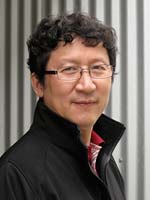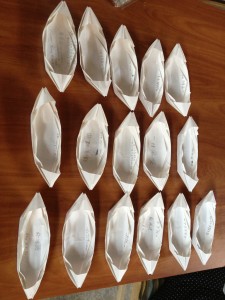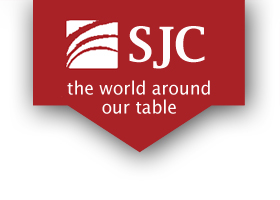
Artist Statement: Professor Gu Xiong, SJC Faculty Fellow
Waterscapes: Johannean Journeys
1,000 hand made white archive paper boats
Permanent Collection of St. John’s College, University of British Columbia
As children we loved to fold paper boats and float them down the stream. We believed that they carried our hopes for the future, for going out into the world, into unknown places. This work explores the idea of migrations, including my own from China to Canada, by imaginatively bringing the Yangtze and Fraser rivers together. My home city of Chongqing is on the banks of the Yangtze while the Fraser flows past Vancouver, my “new” home since 1990. Both rivers are formed by smaller rivers joining together as they flow through different geographies and locales. From opposite directions, they merge and meet in the Pacific Ocean.
In my experience, rivers signify encounters with different peoples and cultures. For me, there were no bridges to help me cross these rivers: you just have to jump in and swim a long distance in order to experience another culture by being open to benefiting from differences. There is inevitably conflict in this process. I have asked myself, how can I bring the two rivers in my life together? The answer: I have to become like a river myself—a river of migration, a river of transcultural identities, a river of change and uncertainty—in order to shape these forces into a new global space.
At St. John’s College, “Waterscapes” is inspired by the stories of Johannean journeys from all over the world. The Founders of the College are alumni of St. John’s University of Shanghai, the largest metropolis on the Yangtze. Every year, new residents come to UBC from all over the world. Like the boats, each of their stories is uniquely individual, but they come together to form a thick palimpsest of histories, memories, and material traces of migration and transformation. Migration and globalization have brought the invisible and the visible together, creating new spaces in which life journeys intertwine and new paths on which to build our present and future.
Water, people, and time flow on. They do not return to their original points but show it is possible for life itself to flow on.
2013
The artist gratefully acknowledges the generous support of the Social Sciences and Humanities Research Council of Canada as well as his research team: Chris Lee, Jennifer Chun and April Liu. Special thanks to the principal of St. John’s College Principal, Henry Yu, the staff, and the many student volunteers who helped make this work possible for the public.
交融的河流: 约翰人之旅
艺术家: 顾雄
2013年
一千只白色档案纸手制船
加拿大不列颠哥伦比亚大学圣约翰学院永久收藏
孩童时期,我们喜欢将折好的小纸船放入水中随着水流飘向远方,它们带走了我们对未来的希望,以及对外面的世界的憧憬。在作品中我探索关于迁移的主题,在将长江与菲沙河交融的过程中,使作品融入我自身从中国迁移到加拿大的移民经历。我的故乡重庆是在长江与嘉陵江交汇的河畔,而菲沙河的水流经过我在温哥华的新家。两条河流都由许多更小的河流在不同地域交织而成,从相反的方向汇入太平洋。
在我的经历中,这些河流象征着与不同民族和文化的相遇。对我来说,并没有一座可以帮我越过这些河流的桥梁:你不得不跳入水中,并且游上很长很长的一段距离后,才能在接受差异中的益处里体验另一种文化,这是必不可少的过程。我曾问我自己,如何才能将我生命中的两条河流融合在一起?答案是:我必须自己变为一条河流—— 一条迁移的河流,一条跨文化身份的河流,一条充满变换与不确定的河流——才可能将这些力量转换并组构成全球化中的全新空间。
在圣约翰学院,交融的河流受到来自全世界约翰人之旅的故事的启发。学院的创办人是上海圣约翰大学的校友,而上海则是长江流域内最大的都市。我们的学生从世界各地来到不列颠哥伦比亚大学,就如同这些纸船一样,每一个故事都是一个独特的个体,当他们结合在一起,便成为一个承载着历史,记忆,和物质迁移转化痕迹的厚重的重写本。移民和全球化将可见的与无形的融为一体,并形成全新的空间,在那里将生命旅程编织为一条谱写我们今日与未来的新道路。
水,人,时间,都在不停地流动,他们再也不会回到原本的地点,但却展示了他们自身移动的生生不息的生命力。
顾雄
2013年
艺术家由衷地感谢加拿大社会科学与人文研究委员会,以及本项目的研究小组成员:李明皓,珍妮弗·千,和刘诗源。特别感谢圣约翰学院校长余全毅,全部工作人员,以及许许多多的学生志愿者,他们的大力帮助使这件作品得以呈现在公众的面前。

